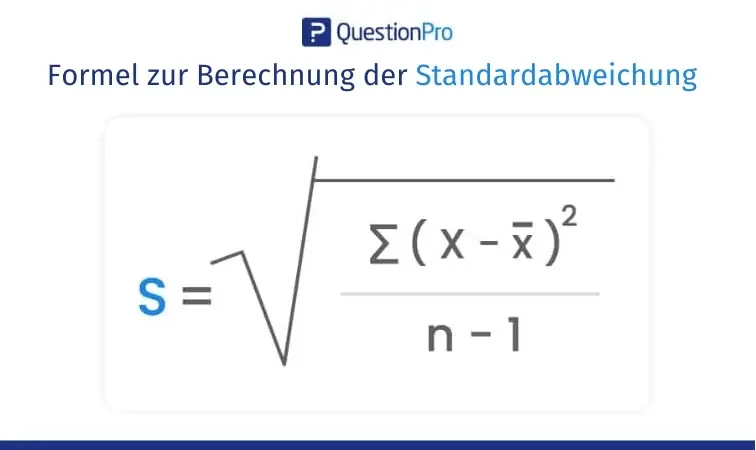Market research
The standard deviation is one of the most important statistical measures when calculating a research sample and also a risk measure used by analysts, portfolio managers and consultants.
This article describes what standard deviation is, what it is used for and how to get it step by step.
CONTENT
- 1 What is standard deviation?
- 2 Example formula for standard deviation
- 3 How do you calculate the standard deviation of a sample?
- 4 The importance of standard deviation
- 4.1 Standard deviation includes all observations.
- 4.2 Can be used in combination
- 4.3 It can be used to determine whether a quantity is unevenly distributed.
- 4.4 You can use standard deviation to perform mathematical and statistical analysis.
- 4.5 It makes it possible to determine the volatility of an investment
- 5 4 areas of application of standard deviation
- 6 Conclusion
- 7 1:1 Live Online Presentation: QUESTIONPRO MARKET RESEARCH SOFTWARE
- 8 Try software for market research and experience management now for 10 days free of charge!
What is standard deviation?
The standard deviation is a measure of the spread or variability in the descriptive statistics. It is used to calculate the variation or spread by which individual data points deviate from the mean.
A low deviation indicates that the data points are very close to the mean, while a high deviation shows that the data is spread over a larger range of values.
In marketing, variance can help account for large fluctuations in costs or sales.
Standard deviation also helps in determining the dispersion of asset prices from their average price and volatility in the market.
Also find out what the mean deviation at a hunt.
Example formula for standard deviation
Standard deviation is a key component in calculating the size of the research sample. The formula for calculating them is as follows:
* S = standard deviation.
* ∑ = sum of.
* X = Any value.
* x̅ = Arithmetic mean.
How do you calculate the standard deviation of a sample?
To calculate the standard deviation of a sample, simply follow these steps:
- Calculate the mean of all data points. The mean is calculated by adding all data points and dividing by the number of data points.
- Calculate the variance of each data point, by subtracting the measure of the mean from the value of the data point.
- Square those obtained in step 2 Variance each data point.
- Add up those in step 3 obtained values of the squared variance.
- Divide the sum of the obtained in step 4 squared variance values by the number of data points in the data set minus 1.
- Take the square root from the quotient of the result obtained in step 5.
The importance of standard deviation
Standard deviation is an important factor for statistical analysis. Some reasons for this are:
Standard deviation includes all observations.
One advantage of deviation is that every data point is included in the analysis. Other deviation measures, such as B. the span, only measure the points that are furthest apart, without taking into account the points in between. Therefore, standard deviation is often considered a more robust and accurate measure compared to other observations.
Can be used in combination
The standard deviation of two data sets can be combined using a special combined deviation formula. There are no similar formulas for other measures of dispersion in statistics. In addition, unlike other observational measures, standard deviation can be used in other algebraic calculations.
It can be used to determine whether a quantity is unevenly distributed.
Standard deviation is particularly useful when you want to know the extent to which your data set is unevenly distributed. It not only provides information about the spread of the data, but also about its uneven distribution.
You can use standard deviation to perform mathematical and statistical analysis.
The value of standard deviation is always fixed and well-defined so that both mathematical and statistical analysis can be performed.
It makes it possible to determine the volatility of an investment
The volatility of an investment can be determined by the number of data points that deviate from the mean. The more data points deviate from the mean, the more volatile the investment is.
| Learn more about the Mean, median and mode.
4 areas of application of standard deviation
Some common uses of deviation include:
1. Measuring investment risk
Many investment firms use standard deviation to determine how much the fund's performance deviates from the normal expected return. As is easy to understand, these statistics can be communicated to end customers and investors.
In this way, the deviation allows assessing the volatility of securities in the market and predicting future performance trends.
2. Better understanding of data sets
Standard deviation is used to measure the spread of values in a data set. Individuals and businesses use standard deviation all the time in various areas to better understand data sets.
3. Understand ad performance.
Marketers often calculate the standard deviation of revenue generated by each ad to see what fluctuations in revenue can be expected for a particular ad.
In this section, you can also calculate the variance of the number of ads used by competitors to understand whether competitors are using more or fewer ads than normal in a given period.
4. Use of standard deviation in human resources
One of the responsibilities of a human resources manager is to calculate the standard deviation of salaries in a particular area in order to know what type of salary deviation to offer new employees.
Conclusion
Now that you know all the basics about standard deviation, we invite you to learn more about using this and other research measures and techniques in a practical way in our Advanced Research Methodology ebook.
Don't forget that it's completely free, as is our sample calculator to help you find the ideal population for your studies, and of course our online survey platform Create your account now!
1:1 live online presentation:
QUESTIONPRO MARKET RESEARCH SOFTWARE
Arrange an individual appointment and discover our market research software.
Try software for market research and experience management now for 10 days free of charge!
Do you have any questions about the content of this blog? Simply contact us via contact form. We look forward to a dialogue with you! You too can test QuestionPro for 10 days free of charge and without risk in depth!
Test the agile market research and experience management platform for qualitative and quantitative data collection and data analysis from QuestionPro for 10 days free of charge
FURTHER KEYWORDS
SHARE THIS ARTICLE
KEYWORDS OF THIS BLOG POST
standard deviation | Formula | Market research
FURTHER INFORMATION
- Research Synthesis: Understand your research results
- Problem statement: What it is, how to formulate it and examples
- Research Process: Steps to conduct the research
- Types of research and their features
- Digital behavioral data: what it is, its importance and risks
- Data filtering: what it is, benefits and examples
- Data Science and Artificial Intelligence: Which is Better?
- Big Data and Artificial Intelligence: How do they work together?




